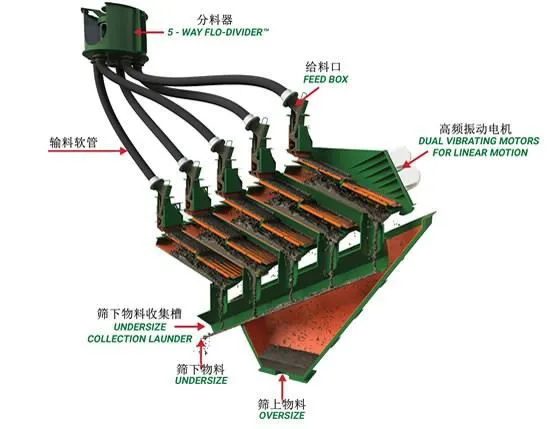
These are some of the common types of quartz sand screening equipment used in various industries. The choice of screening equipment depends on factors such as the desired particle size distribution, throughput capacity, and the specific requirements of the application.Here are some common types of quartz sand screening equipment:
Vibrating Screens: Vibrating screens are versatile equipment used for screening various materials, including quartz sand. They consist of a vibrating surface (screen deck) with openings of different sizes to allow particles to pass through. Vibrating screens can be single or multi-deck, depending on the application, and they can be inclined or horizontal.
Trommel Screens: Trommel screens are cylindrical drums with perforated screens that rotate to separate materials by size. Quartz sand is fed into one end of the trommel, and as it rotates, the smaller particles pass through the screen, while larger particles are discharged at the other end. Trommel screens are often used for large-scale quartz sand screening operations.
Rotary Screens: Rotary screens, also known as drum screens or rotary sieves, are similar to trommel screens but operate with a different mechanism. They consist of a rotating drum with perforated screens that allow particles to be separated based on size. Rotary screens are commonly used in quartz sand processing plants for coarse screening.
High-Frequency Screens: High-frequency screens utilize high-frequency vibration to improve the screening efficiency of fine particles, including quartz sand. These screens typically have a higher frequency and smaller amplitude compared to conventional vibrating screens, allowing for better separation of fine particles.
Flip Flow Screens: Flip flow screens are designed to handle difficult-to-screen materials, including moist and sticky quartz sand. They feature elastic mesh panels that vibrate independently, reducing blinding and clogging of the screen surface. Flip flow screens are effective for fine screening of quartz sand with high moisture content.
Air Classifiers: Air classifiers use air streams to separate particles based on size, shape, and density. They are commonly used in quartz sand processing plants to remove impurities and classify the sand into different size fractions. Air classifiers are particularly useful for producing high-purity quartz sand for applications requiring strict quality control.
Hydrocyclones: Hydrocyclones are cyclonic separation devices used to separate particles from a liquid suspension based on density. They are often used in conjunction with other screening equipment to remove fine particles and impurities from quartz sand slurries.

Quartz sand screening equipment, such as vibrating screens or trommel screens, play a crucial role in the processing of quartz sand. These screening equipments offer several advantages that contribute to efficient and effective sand screening operations. Here are some key advantages of quartz sand screening equipment:
High Screening Efficiency: Quartz sand screening equipment is designed to efficiently separate particles based on size. Vibrating screens and trommel screens employ different mechanisms to achieve high screening efficiency, ensuring that only properly sized particles pass through while oversize particles are rejected.
Versatility: Quartz sand screening equipment is versatile and can be used for a wide range of applications. It can handle various types of quartz sand, including dry or wet sand, coarse or fine sand, and even mixed materials. This versatility makes it suitable for use in different industries such as mining, construction, and foundries.
Customization Options: Many quartz sand screening equipment manufacturers offer customization options to tailor the equipment to specific requirements. This includes options such as adjustable screen panels, variable speed controls, and different screen configurations to optimize performance for different types of quartz sand and processing conditions.
Low Maintenance: Quartz sand screening equipment is typically designed for low maintenance operation. They are built with durable materials and components that can withstand the abrasive nature of quartz sand and the rigors of continuous operation. Minimal maintenance tasks such as lubrication and occasional screen panel replacement are usually required to keep the equipment running smoothly.
High Throughput Capacity: Vibrating screens and trommel screens are capable of handling large volumes of quartz sand, making them suitable for high-throughput screening applications. Their robust construction and efficient screening mechanisms allow for continuous operation at high feed rates, maximizing production output and efficiency.
Effective Particle Separation: Quartz sand screening equipment effectively separates particles based on size, ensuring accurate particle classification and separation. This results in consistent product quality and helps to meet specific size requirements for different applications such as glass manufacturing, foundry casting, and water filtration.
Space-Efficient Design: Many quartz sand screening equipment models feature a compact and space-efficient design, making them suitable for installation in constrained plant layouts or mobile screening applications. This allows for easy integration into existing processing plants or transportation to remote job sites.
Environmental Benefits: Efficient quartz sand screening equipment helps to minimize environmental impact by reducing the need for manual screening processes and optimizing resource utilization. By automating the screening process, it reduces labor requirements and energy consumption, resulting in cost savings and environmental benefits.

ZSK eccentrics series linear vibrating screen is a new and efficient universal screening equipment, screen box trajectory which is approximately a straight line. This series of screen machine embodies most of the advantages of a biaxial linear screen, with the most extensive scope and application prospects.
READ MORE
A flip flop vibrating screen is a type of vibrating screen that utilizes the principle of elasticity to effectively screen and separate fine materials. This unique design creates a flip-flop motion during the screening process, which helps prevent material blinding and pegging.
READ MORE
Quartz sand screening equipment is essential in the processing of quartz sand to separate and classify particles of different sizes. These equipments ensure that the quartz sand meets the required specifications for various applications, including glassmaking, foundry work, ceramics, construction, and abrasives.
READ MORECopyright © 2023 Xinxiang Zongyuan Machinery Equipment Co., Ltd. | All Rights Reserved.